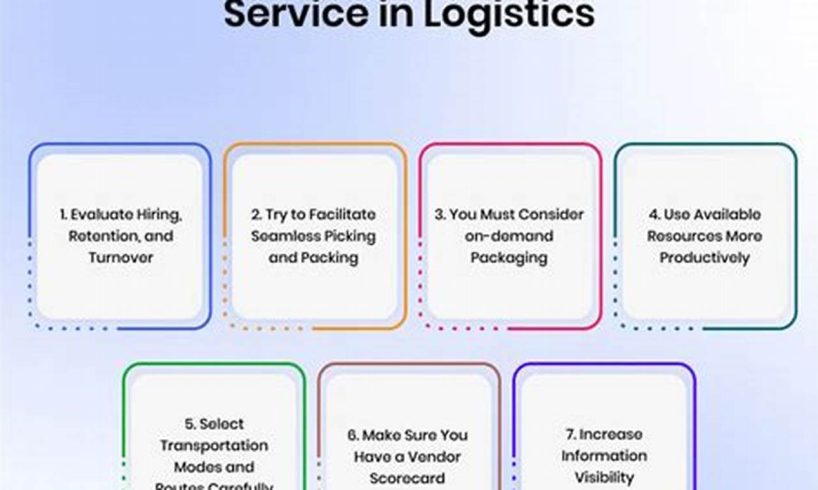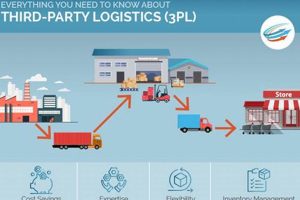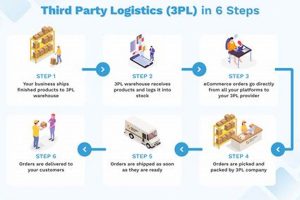
Customer service and logistics management are two essential components of any successful business. Customer service is responsible for ensuring that customers are satisfied with their experience with a company, while logistics management is responsible for ensuring that products and services are delivered to customers in a timely and efficient manner. While these two functions may seem unrelated, they are actually closely interconnected. Effective logistics management can have a significant impact on customer satisfaction, and vice versa.
One of the most important ways that logistics management can impact customer satisfaction is by ensuring that products are delivered on time and in good condition. When customers receive their orders on time and in good condition, they are more likely to be satisfied with their experience with the company. On the other hand, late deliveries or damaged products can lead to customer dissatisfaction and even lost sales. In addition to ensuring that products are delivered on time and in good condition, logistics management can also impact customer satisfaction by providing customers with visibility into the delivery process. When customers can track their orders online or via a mobile app, they are more likely to be satisfied with their experience, even if the delivery is delayed.
Customer service is also essential for ensuring that customers are satisfied with their experience with a company. Customer service representatives can help customers with a variety of issues, such as placing orders, tracking shipments, and resolving complaints. When customer service representatives are knowledgeable, helpful, and friendly, they can help to build customer loyalty and trust. On the other hand, poor customer service can lead to customer dissatisfaction and even lost sales.
1. Order fulfillment
Order fulfillment is a critical part of the logistics management process. It involves picking, packing, and shipping orders to customers. Customer service representatives (CSRs) play a vital role in order fulfillment by ensuring that orders are processed and fulfilled accurately and on time.
- Accuracy: CSRs check orders for accuracy before they are shipped. This includes verifying the customer’s name and address, as well as the quantity and type of products ordered. By ensuring that orders are accurate, CSRs help to prevent delays and errors.
- Timeliness: CSRs work to ensure that orders are shipped on time. This involves coordinating with the warehouse and shipping carrier to make sure that orders are picked, packed, and shipped as quickly as possible. By ensuring that orders are shipped on time, CSRs help to keep customers satisfied.
- Customer communication: CSRs communicate with customers throughout the order fulfillment process. They provide customers with order updates, tracking information, and answers to questions. By keeping customers informed, CSRs help to build trust and confidence.
Overall, CSRs play a vital role in order fulfillment by ensuring that orders are processed and fulfilled accurately and on time. This helps to keep customers satisfied and builds trust and confidence in the company.
2. Shipping and delivery
Shipping and delivery is a critical part of the customer experience. When customers order products online, they expect to receive them in a timely and efficient manner. CSRs play a vital role in shipping and delivery by tracking shipments and providing customers with updates on the status of their orders.
By tracking shipments, CSRs can proactively identify and resolve any potential delays or issues. This helps to keep customers informed and prevents them from having to contact customer service with inquiries about the status of their orders. In addition, CSRs can provide customers with accurate and up-to-date information on the estimated delivery date and time. This helps customers to plan their schedules and avoid any inconvenience.
The ability to track shipments and provide customers with updates on the status of their orders is a valuable service that can help to improve customer satisfaction and loyalty. When customers know that they can rely on CSRs to keep them informed about the status of their orders, they are more likely to be satisfied with their overall experience.
Here is a real-life example of how shipping and delivery is related to customer service:
A customer orders a product online and receives an email confirmation with a tracking number. The customer can then track the status of their order online or via a mobile app. The customer receives an email notification when the order is shipped and another email notification when the order is delivered. The customer is also able to contact customer service at any time for updates on the status of their order.
This example illustrates how shipping and delivery is an important part of customer service. By tracking shipments and providing customers with updates on the status of their orders, CSRs can help to ensure that customers have a positive experience.
3. Returns and exchanges
The connection between returns and exchanges and customer service is evident in various aspects of logistics management.
- Customer satisfaction: Returns and exchanges are a critical factor in customer satisfaction. When customers are able to easily return or exchange products that they are not satisfied with, they are more likely to be satisfied with their overall shopping experience. CSRs play a vital role in handling returns and exchanges in a way that ensures customer satisfaction. They can provide customers with clear instructions on how to return or exchange products, process returns and exchanges quickly and efficiently, and communicate with customers throughout the process to keep them informed.
- Inventory management: Returns and exchanges can also impact inventory management. When products are returned, they need to be processed and restocked. CSRs can work with the warehouse team to ensure that returned products are processed quickly and efficiently. They can also track returned products to identify trends and patterns, which can help the company to improve its inventory management practices.
- Customer loyalty: Returns and exchanges can also impact customer loyalty. When customers have a positive experience with returns and exchanges, they are more likely to be loyal customers. CSRs can build customer loyalty by handling returns and exchanges in a way that is fair, efficient, and customer-focused.
Overall, returns and exchanges are an important part of customer service and logistics management. By handling returns and exchanges in a way that ensures customer satisfaction, CSRs can help to improve the overall customer experience and build customer loyalty.
4. Customer inquiries
Customer inquiries are a vital part of customer service and logistics management. When customers have questions about products, services, or orders, they often reach out to CSRs for assistance. CSRs play a crucial role in answering these inquiries accurately and efficiently. By providing customers with the information they need, CSRs can help to improve the customer experience and build customer loyalty.
There are many different types of customer inquiries that CSRs may encounter. Some of the most common include:
- Questions about product availability and pricing
- Questions about order status and delivery
- Questions about returns and exchanges
- Questions about product usage and troubleshooting
- Questions about company policies and procedures
CSRs must have a deep understanding of the company’s products, services, and policies in order to answer customer inquiries accurately. They must also be able to communicate effectively with customers, both verbally and in writing. In addition, CSRs must be patient and understanding, as customers may be frustrated or upset when they contact customer service.
When CSRs are able to answer customer inquiries quickly and efficiently, it can have a positive impact on the customer experience. Customers are more likely to be satisfied with their experience if they are able to get the information they need quickly and easily. In addition, CSRs can help to build customer loyalty by providing customers with personalized service and support.
Here is a real-life example of how customer inquiries are related to logistics management:
A customer calls customer service to inquire about the status of their order. The CSR checks the order status and informs the customer that their order is currently being processed and is expected to ship within the next 24 hours. The customer is satisfied with the response and thanks the CSR for their assistance.
This example illustrates how customer inquiries can be related to logistics management. By answering customer inquiries about order status, CSRs can help to keep customers informed and prevent them from having to contact customer service multiple times.
5. Problem resolution
Problem resolution is a critical component of customer service and logistics management. When customers experience problems with their orders or products, they often reach out to CSRs for assistance. CSRs play a crucial role in resolving these problems quickly and efficiently. By doing so, they can help to ensure that customers have a positive experience and are more likely to do business with the company again in the future.
There are many different types of problems that CSRs may encounter. Some of the most common include:
- Shipping delays or errors
- Damaged or defective products
- Billing errors
- Product returns or exchanges
- Customer complaints
CSRs must have a deep understanding of the company’s products, services, and policies in order to resolve customer problems effectively. They must also be able to communicate effectively with customers, both verbally and in writing. In addition, CSRs must be patient and understanding, as customers may be frustrated or upset when they contact customer service.
When CSRs are able to resolve customer problems quickly and efficiently, it can have a positive impact on the customer experience. Customers are more likely to be satisfied with their experience if they are able to get their problems resolved quickly and easily. In addition, CSRs can help to build customer loyalty by providing customers with personalized service and support.
Here is a real-life example of how problem resolution is related to logistics management:
A customer orders a product online, but the product is damaged when it arrives. The customer contacts customer service, and the CSR immediately initiates a return and refund. The CSR also sends the customer a replacement product free of charge. The customer is satisfied with the resolution and is more likely to do business with the company again in the future.
This example illustrates how problem resolution is an important part of customer service and logistics management. By resolving customer problems quickly and efficiently, CSRs can help to ensure that customers have a positive experience and are more likely to do business with the company again in the future.
6. Feedback collection
Feedback collection is an essential part of customer service and logistics management. When customers provide feedback about their experiences, companies can use this information to identify areas for improvement. This can lead to better logistics operations, which can in turn improve customer satisfaction.
There are many ways to collect customer feedback. CSRs can collect feedback through surveys, emails, phone calls, and social media. It is important to collect feedback from a variety of sources to get a complete picture of customer experiences.
Once feedback has been collected, it is important to analyze it and identify trends. This information can then be used to make improvements to logistics operations. For example, if customers are complaining about slow shipping times, the company may need to invest in faster shipping methods. Or, if customers are complaining about damaged products, the company may need to improve its packaging.
By collecting and analyzing customer feedback, companies can improve their logistics operations and provide better customer service. This can lead to increased customer satisfaction and loyalty.
Here is a real-life example of how feedback collection can be used to improve logistics operations:
A company was experiencing a high number of customer complaints about late deliveries. The company collected feedback from customers and found that the delays were due to inefficiencies in the shipping process. The company then made changes to its shipping process, which resulted in a significant reduction in delivery times.
This example illustrates how feedback collection can be used to identify and resolve problems in logistics operations. By collecting and analyzing customer feedback, companies can improve their operations and provide better customer service.
7. Customer relationship management
Customer relationship management (CRM) is an important part of customer service and logistics management. CSRs play a vital role in building relationships with customers, which can lead to increased customer loyalty. When customers feel like they have a personal connection with the company, they are more likely to do business with that company again and again.
There are many ways that CSRs can build relationships with customers. Some of the most effective methods include:
- Providing excellent customer service
- Being responsive to customer inquiries
- Resolving customer problems quickly and efficiently
- Going the extra mile to meet customer needs
- Personalizing interactions with customers
When CSRs build strong relationships with customers, they create a positive customer experience that can lead to increased customer loyalty. Loyal customers are more likely to make repeat purchases, recommend the company to others, and provide positive feedback.
Here is a real-life example of how customer relationship management can lead to increased customer loyalty:
A customer service representative (CSR) at an online retailer went above and beyond to help a customer who was having trouble finding a product on the website. The CSR spent extra time searching for the product and eventually found it in stock at a different warehouse. The CSR then arranged for the product to be shipped to the customer’s home for free. The customer was so impressed with the CSR’s service that they left a positive review online and became a loyal customer of the retailer.
This example illustrates how CSRs can build relationships with customers by providing excellent customer service and going the extra mile to meet customer needs. By doing so, CSRs can create a positive customer experience that can lead to increased customer loyalty.
8. Brand reputation
In the realm of customer service and logistics management, brand reputation stands as a crucial element that directly correlates with customer satisfaction. Satisfied customers are more inclined to become brand advocates, actively recommending a company to their peers. This positive word-of-mouth serves as a potent force in shaping a company’s brand image and reputation.
- Customer Advocacy: Satisfied customers who have experienced exceptional customer service often transform into ardent brand advocates. They enthusiastically share their positive experiences with friends, family, and social media networks, amplifying the company’s reach and credibility.
- Online Reviews and Testimonials: In today’s digital landscape, online reviews and testimonials hold immense sway over consumer decisions. Satisfied customers are more likely to leave positive reviews and share their experiences on platforms like Google My Business, Yelp, and Trustpilot. These positive reviews not only enhance the company’s online visibility but also serve as a testament to its commitment to customer satisfaction.
- Social Media Engagement: Social media has emerged as a powerful tool for customer engagement and reputation management. Satisfied customers frequently express their appreciation and positive experiences on social media platforms, creating a positive brand perception among potential customers.
- Brand Loyalty: Exceptional customer service fosters brand loyalty, encouraging customers to repeatedly choose a company over its competitors. Satisfied customers are more inclined to make repeat purchases, subscribe to loyalty programs, and actively participate in brand-building initiatives.
In conclusion, brand reputation is inextricably linked to customer service and logistics management. By prioritizing customer satisfaction and delivering exceptional service, companies can cultivate a positive brand image, attract new customers, and drive long-term growth. Satisfied customers become brand ambassadors, spreading positive word-of-mouth and contributing to the company’s reputation as a reliable and customer-centric organization.
FAQs on Customer Service and Logistics Management
Customer service and logistics management are two essential components of any successful business. While they may seem like separate functions, they are actually closely interconnected. Here are answers to some frequently asked questions about the relationship between customer service and logistics management:
Question 1: How does customer service impact logistics management?
Customer service can impact logistics management in several ways. For example, customer service representatives (CSRs) can provide customers with accurate and up-to-date information on the status of their orders, track shipments, and resolve any issues that may arise. By doing so, CSRs can help to ensure that orders are delivered on time and in good condition, which can lead to increased customer satisfaction.
Question 2: How does logistics management impact customer service?
Logistics management can impact customer service in several ways. For example, if a company experiences a delay in shipping an order, the CSRs will need to be able to communicate this to the customer in a timely and accurate manner. Additionally, if a product is damaged during shipping, the CSRs will need to be able to process a return or exchange for the customer. By being able to effectively manage the logistics of an order, companies can ensure that their customers have a positive experience.
Question 3: What are some best practices for customer service and logistics management?
There are several best practices that companies can follow to improve their customer service and logistics management. Some of these best practices include:
- Providing customers with accurate and up-to-date information on the status of their orders
- Tracking shipments and proactively communicating any delays or issues to customers
- Resolving customer issues quickly and efficiently
- Investing in technology to improve the efficiency of logistics operations
- Training CSRs on the importance of customer service and logistics management
Question 4: What are some common challenges in customer service and logistics management?
There are several common challenges that companies face in customer service and logistics management. Some of these challenges include:
- Meeting customer expectations
- Managing customer complaints
- Dealing with shipping delays and other disruptions
- Keeping up with the latest technology
- Finding and retaining qualified staff
Question 5: What are the benefits of integrating customer service and logistics management?
There are several benefits to integrating customer service and logistics management. Some of these benefits include:
- Improved customer satisfaction
- Reduced costs
- Increased efficiency
- Improved communication
- Enhanced visibility into the supply chain
Question 6: What are the key trends in customer service and logistics management?
There are several key trends in customer service and logistics management, including:
- The use of artificial intelligence (AI) to improve customer service and logistics operations
- The growth of e-commerce and the impact on logistics management
- The increasing importance of sustainability in logistics management
- The need for greater collaboration between customer service and logistics management
By understanding the relationship between customer service and logistics management, companies can improve their operations and provide a better experience for their customers.
Please note that these are just a few of the many questions that can be asked about customer service and logistics management. If you have any other questions, please do not hesitate to contact us.
Tips on How Customer Service Relates to Logistics Management
To enhance the connection between customer service and logistics management, consider the following tips:
Tip 1: Foster Collaboration and Communication
Establish open communication channels and regular touchpoints between customer service and logistics teams. This enables seamless information sharing, proactive issue resolution, and improved order tracking.
Tip 2: Leverage Technology for Efficiency
Implement technology solutions such as order management systems and real-time tracking tools. These tools streamline processes, automate tasks, and provide greater visibility into the supply chain, enhancing both customer service and logistics operations.
Tip 3: Set Clear Expectations and Metrics
Define and communicate clear service level agreements (SLAs) and key performance indicators (KPIs) to both teams. This ensures alignment, accountability, and continuous improvement in customer service and logistics performance.
Tip 4: Empower Customer Service Representatives
Provide customer service representatives with in-depth knowledge of logistics processes, product availability, and shipping procedures. This empowers them to resolve customer inquiries efficiently and provide accurate updates.
Tip 5: Track and Analyze Customer Feedback
Regularly collect and analyze customer feedback related to order fulfillment, delivery times, and overall experience. This feedback helps identify areas for improvement and enhance both customer service and logistics operations.
Tip 6: Promote a Customer-Centric Culture
Instill a customer-centric mindset across both customer service and logistics teams. Encourage a focus on meeting customer needs, resolving issues promptly, and exceeding expectations.
Tip 7: Invest in Staff Training and Development
Provide ongoing training to customer service and logistics staff on best practices, new technologies, and industry trends. This investment enhances their skills, improves performance, and fosters a continuous learning environment.
Implementing these tips can strengthen the relationship between customer service and logistics management, leading to improved customer experiences, optimized supply chain operations, and increased business success.
Conclusion
Customer service and logistics management are two essential components of any successful business. They are closely interconnected and can have a significant impact on each other. By understanding the relationship between these two functions, businesses can improve their overall operations and provide a better experience for their customers.
Effective customer service can help to improve logistics management by ensuring that orders are processed and fulfilled accurately and on time. It can also help to track shipments and provide customers with updates on the status of their orders. Additionally, customer service can help to resolve customer complaints and issues, which can help to reduce the number of logistics-related problems.
Effective logistics management can also help to improve customer service by ensuring that products are delivered to customers on time and in good condition. It can also help to provide customers with accurate and up-to-date information on the status of their orders. Additionally, logistics management can help to reduce the number of customer complaints and issues, which can help to improve customer satisfaction.
By working together, customer service and logistics management can help businesses to improve their overall performance. They can help to reduce costs, improve efficiency, and increase customer satisfaction. In today’s competitive business environment, it is more important than ever for businesses to have a strong understanding of the relationship between customer service and logistics management.






